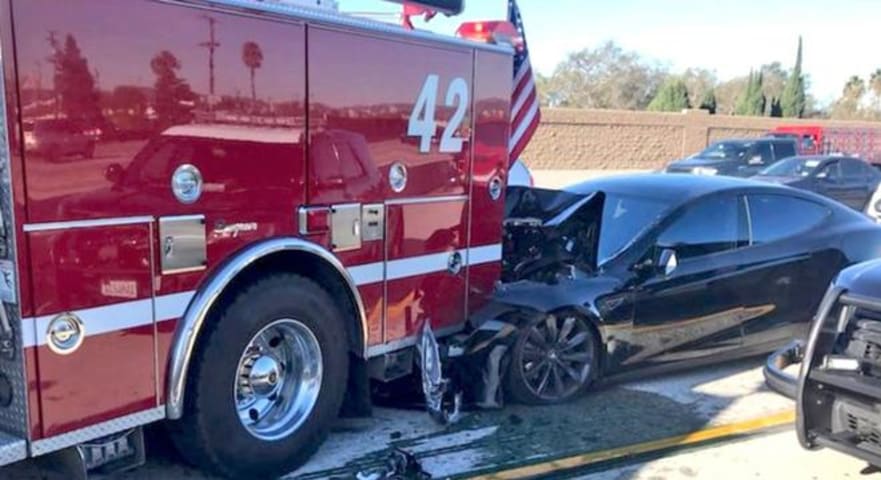Entidades
Ver todas las entidadesEstadísticas de incidentes
Clasificaciones de la Taxonomía CSETv0
Detalles de la TaxonomíaProblem Nature
Specification, Robustness
Physical System
Vehicle/mobile robot
Level of Autonomy
Medium
Nature of End User
Amateur
Public Sector Deployment
No
Data Inputs
360 Ultrasonic Sonar, Image Recognition Camera, Long Range Radar, traffic patterns
Clasificaciones de la Taxonomía CSETv1
Detalles de la TaxonomíaIncident Number
20
Special Interest Intangible Harm
no
Date of Incident Year
2016
Date of Incident Month
05
Date of Incident Day
07
Estimated Date
No
Clasificaciones de la Taxonomía CSETv1_Annotator-1
Detalles de la TaxonomíaIncident Number
20
Special Interest Intangible Harm
no
Date of Incident Year
2016
Date of Incident Month
05
Date of Incident Day
07
Estimated Date
No
Informes del Incidente
Cronología de Informes

- Ver el informe original en su fuente
- Ver el informe en el Archivo de Internet
Un Tesla Model S con el sistema de piloto automático activado estuvo involucrado en un accidente fatal, la primera fatalidad conocida en un Tesla donde el piloto automático estaba activo. La compañ�ía reveló el accidente en una publicación d…

- Ver el informe original en su fuente
- Ver el informe en el Archivo de Internet
Un auto autónomo de Uber mató a un peatón en Arizona el domingo por la noche. Fue en modo de conducción autónoma, ocurrió alrededor de las 10 p.m. y había un operador de vehículo en el asiento delantero. En una declaración enviada por corre…

- Ver el informe original en su fuente
- Ver el informe en el Archivo de Internet
Los defensores de la autonomía tienden a citar mejoras generales en la seguridad vial en un futuro de automóviles autónomos. El noventa y cuatro por ciento de los accidentes automovilísticos son causados por errores del conductor, y tanto l…

- Ver el informe original en su fuente
- Ver el informe en el Archivo de Internet
Es el año 2025. Su automóvil sin conductor acaba de chocar contra un árbol a 55 mph porque su computadora incorporada valora la vida de un peatón por encima de la suya. Tus heridas son el resultado de unas pocas líneas de código que fueron …

- Ver el informe original en su fuente
- Ver el informe en el Archivo de Internet
LOS GATOS, California (Reuters) - Tesla Inc (TSLA.O) dijo el viernes que un Tesla Model X involucrado en un accidente fatal en California la semana pasada había activado su sistema de piloto automático, lo que generó nuevas preguntas sobre …

- Ver el informe original en su fuente
- Ver el informe en el Archivo de Internet
Tesla confirmó que su función de conducción autónoma, Autopilot, estuvo involucrada en un accidente fatal que ocurrió en California. Walter Huang, el conductor del Model X, golpeó un atenuador de tráfico comprimido y murió a pesar de tener …

- Ver el informe original en su fuente
- Ver el informe en el Archivo de Internet
La compañía dijo que el conductor, Wei Huang, de 38 años, ingeniero de software de Apple, había recibido varias advertencias visuales y audibles para que volviera a poner las manos en el volante, pero no lo hizo, a pesar de que su modelo X …

- Ver el informe original en su fuente
- Ver el informe en el Archivo de Internet
El fabricante de automóviles eléctricos Tesla ha confirmado que su función de "piloto automático" se activó durante un accidente fatal la semana pasada, un desarrollo que exacerbará las preocupaciones sobre la seguridad de los vehículos fut…

- Ver el informe original en su fuente
- Ver el informe en el Archivo de Internet
Tesla se está tomando muy en serio las relaciones públicas después de que uno de sus vehículos en modo autónomo matara a un pasajero recientemente.
El accidente ocurrió a las 9:27 a. m. en la autopista 101 cerca de Mountain View, California…

- Ver el informe original en su fuente
- Ver el informe en el Archivo de Internet
A principios de esta semana, la policía de Tempe, Arizona, publicó un video del fatal accidente que involucró a un peatón y un vehículo autónomo de Uber. Pedimos a los expertos que analizaran las imágenes y explicaran qué factores pueden ha…

- Ver el informe original en su fuente
- Ver el informe en el Archivo de Internet
La compañía de automóviles eléctricos Tesla ha confirmado que un accidente fatal reciente que involucró a uno de sus vehículos ocurrió mientras el automóvil estaba en modo de piloto automático.
Tesla publicó una publicación de blog la seman…

- Ver el informe original en su fuente
- Ver el informe en el Archivo de Internet
La seguridad del piloto automático de Tesla volvió a estar en primer plano después de que se confirmara que el sistema de asistencia al conductor estaba activado durante el fatal accidente que mató al propietario de un Model X en Mountain V…

- Ver el informe original en su fuente
- Ver el informe en el Archivo de Internet
Los defensores de la seguridad del consumidor y los expertos en vehículos autónomos criticaron a Tesla Inc. por emitir otra declaración sobre la muerte de un cliente que culpó a la falta de atención del conductor.
Días después de publicar u…

- Ver el informe original en su fuente
- Ver el informe en el Archivo de Internet
Después de hacer repetidas declaraciones sobre una investigación gubernamental en curso sobre un accidente fatal que involucró a Autopilot, Tesla fue expulsada de la investigación que lleva a cabo la Junta Nacional de Seguridad en el Transp…

- Ver el informe original en su fuente
- Ver el informe en el Archivo de Internet
CERRAR La Junta Nacional de Seguridad en el Transporte está investigando un accidente e incendio que involucró a un automóvil Telsa Model S. Dos adolescentes murieron en un accidente en Fort Lauderdale, Florida el martes. No se espera que l…

- Ver el informe original en su fuente
- Ver el informe en el Archivo de Internet
Una inspección más detallada de las estadísticas de seguridad del piloto automático de Tesla
Fuente: Tesla, Inc.
La industria automotriz está al comienzo de un gran experimento. Si tiene éxito total, la humanidad podría ser conducida a una …

- Ver el informe original en su fuente
- Ver el informe en el Archivo de Internet
Los defensores de la tecnología de autos sin conductor a menudo promocionan una estadística: más de 37,000 personas murieron en accidentes automovilísticos cada año durante al menos los últimos dos años.
Los autos sin conductor ayudarían a …

- Ver el informe original en su fuente
- Ver el informe en el Archivo de Internet
En esta foto de archivo del 29 de septiembre de 2015, Elon Musk, director ejecutivo de Tesla Motors Inc., presenta el auto Model X en la sede de la compañía en Fremont, California. Durante años, Tesla se ha jactado de que sus autos y SUV so…
- Ver el informe original en su fuente
- Ver el informe en el Archivo de Internet
Resumen ejecutivo Resumen ejecutivo El viernes 23 de marzo de 2018, alrededor de las 9:27 a. Carretera 101 (US-101) en Mountain View, condado de Santa Clara, California. Cuando el vehículo se acercó al cruce de la US-101/State Highway (SH-…

- Ver el informe original en su fuente
- Ver el informe en el Archivo de Internet
Maria Smith se sentó en su porche delantero en Holbrook y recordó su aterradora experiencia en diciembre pasado mientras conducía a casa desde la universidad.
Un policía estatal de Massachusetts acababa de detener al joven de 21 años alrede…

- Ver el informe original en su fuente
- Ver el informe en el Archivo de Internet
La policía está investigando la posibilidad de conducir ebrio en el caso de un conductor de Tesla en Arizona que dijo que estaba usando el controvertido sistema de "piloto automático" del fabricante de automóviles eléctricos del Área de la …

- Ver el informe original en su fuente
- Ver el informe en el Archivo de Internet
La policía de Carolina del Norte presentó cargos contra un conductor cuyo Tesla se estrelló contra un coche de policía la madrugada del miércoles, informa la televisión CBS 17 de Raleigh. El conductor admitió ante los oficiales que había ac…
Variantes
Incidentes Similares
Did our AI mess up? Flag the unrelated incidents
Incidentes Similares
Did our AI mess up? Flag the unrelated incidents

























